| 1 | Thornscrub vine snake |
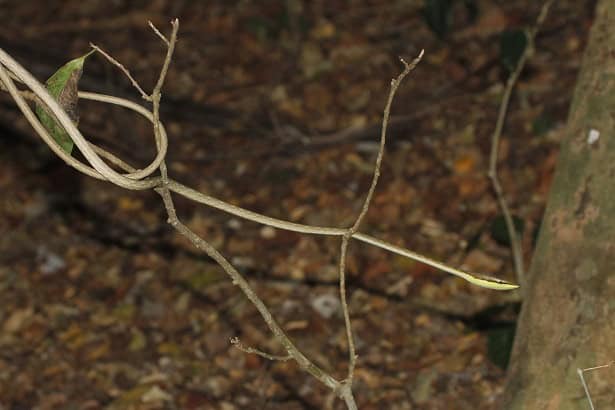
A mostly harmless species which reaches a confirmed maximum of 152cm. Thornscrub vine snakes belong to the Oxybelis genus and are closely related to the green and brown vine snakes of South America. But this species inhabits dry Mexico instead, including the vast majority of western Mexico, and they just cross the border into extreme southern Arizona, making it the only vine snake to inhabit the USA (plus the northernmost vine snake).
Thornscrub vine snakes appear in areas with trees and dry scrubby bushes, never in big cities and urban areas. On a rocky hillside, the green vine snake would be lost and confused. In the open ocean, they’d be flooded with sea salt and dehydrate within hours. But on tree branches, they’re the undisputed master.
Thornscrub vine snakes secrete a mild venom from their rear fangs, but are responsible for no confirmed human deaths. They’re completely fluent in the world of tree branches, slithering onto the next one without even thinking. Their confidence is justified, as they can weave along even the thinnest branches without weighing them down, like a tightrope walker.
Thornscrub vine snakes (Oxybelis microphthalmus) prey on reptiles such as common spotted whiptails, which they’re capable of hunting on branches several metres above ground. Their body is exceptionally thin, one of the thinnest in Mexico relative to length. They’re nimble and agile, and all these features combine to grant them access to branches a rattlesnake couldn’t dream of crossing.
| 2 | Giant parrot snake |
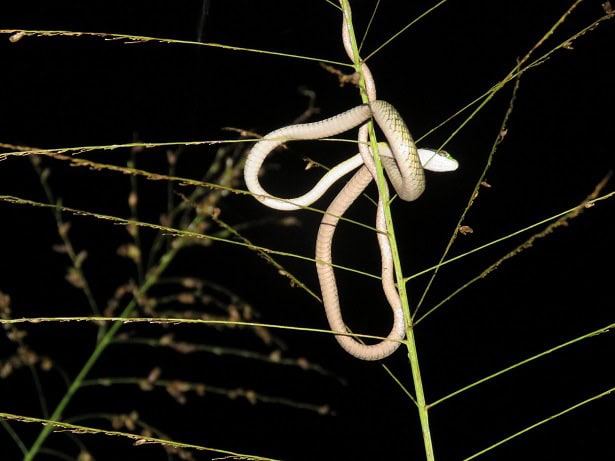
Many snakes can ascend trees if they concentrate, by keeping their slithering movements precise and careful, but the giant parrot snake (Leptophis ahaetulla) ascends trees so effortlessly that it’s like they don’t realise they’re there.
The giant parrot snake is a mildly venomous branch dweller, which reaches a maximum of 172cm, and is capable of causing minor swelling and pain in humans. This species inhabits most of central America and virtually all of Brazil, and is a snake often found darting harmlessly around the heads of hikers in forests. The giant parrot snake splits its time between trees and the ground, and is primarily a lizard hunter.
From what’s known, their main skills are being extremely agile in trees, and identifying even the slightest flicker of an anole (such as bighead anoles) dashing past. This species would die in a desert, but can approach a tree and slither up its trunk without even stopping to think. Once they’ve ascended, they can rest on the thinnest branches imaginable. They’re equally skilful at crossing flimsy overlapping branches, granting them access to new areas of the canopy.
Giant parrot snakes lose none of their tree-inhabiting skills with age. Burmese pythons, for example, will ascend to 1-2 metres as younglings, but do so far less commonly in adulthood as their bulk mounts. Meanwhile, parrot snakes stay light and nimble their entire lives. Parrot snakes are a mostly harmless part of Central and South America’s snake fauna.
| 3 | Green tree snake (Aus) |
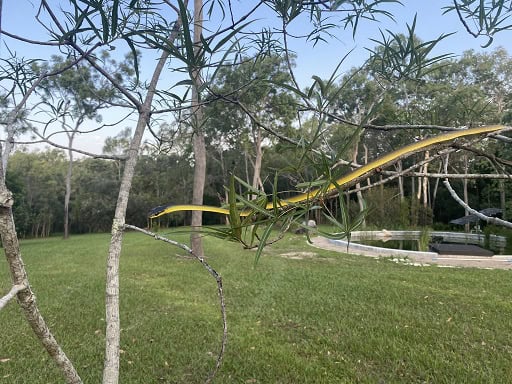
The Dendrelaphis genus owes its entire existence to resting on the thinnest, spindliest branches which the majority of snakes cannot cope with. Southwest Asia has over 30 Dendrelaphis members, including the painted bronzeback (D. pictus), but Australia has just 1 member, the green tree snake (D. punctatus). This species was discovered probably the moment European colonists first stepped off their ships in the 1700s, as it’s absolutely everywhere along Australia’s east coast, including in cities like Sydney.
At up to 1.64 metres, Dendrelaphis punctatus is one of the largest bronzebacks worldwide. Yet this proves no barrier to coiling around spindly, thin branches like spaghetti. Dendrelaphis punctatus can rest on branches that a human wouldn’t dream of putting their foot on. They split their time between the ground and branches, and are a fast, nimble species on both.
Unlike Australia’s green tree python, Dendrelaphis angusticeps isn’t an ambush snake, preferring to actively pursue its frog prey in the tangled world of branches. Literally any thin, spindly branch can serve as a highway to their next meal. Their light, thin bodies mean that almost anywhere is open to them.
When crossing the thinnest branches, Dendrelaphis punctatus doesn’t even make a sudden dash; they just cross from one branch to the next as effortlessly as a human crossing a steel bridge across a river. This species also has a rare tendency to be blue in some individuals.
| 4 | Kelung catsnake |
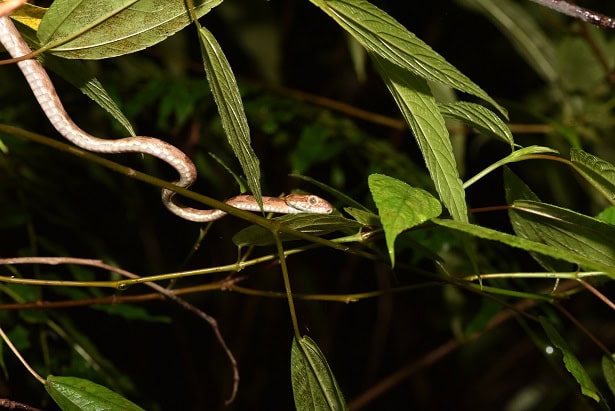
The resident catsnake of southeast China and Taiwan, with the usual nocturnal nature and vertical slits of pupils of its family. The final signature characteristic of the Boiga clan is dwelling on branches, and this includes incredibly thin ones. While Kelung catsnakes (Boiga kraepelini) aren’t lazy, they’re not hyperactive sprinters like a bronzeback. Instead, they love to coil and intertwine themselves with a branch, much like a real cat likes to intertwine itself with its master.
Kelung catsnakes measure up to 160cm, and prey heavily on birds’ eggs, stealing them directly from nests in trees. This snake is extremely secure even on the flimsiest of branches. Even a push and a shove probably couldn’t send them plummeting (though it might enrage them). On Taiwan, this is the only catsnake species, so if you see a beige 1 metre snake above you with vertical pupils and orange blotches, it’s most likely the Kelung catsnake.
Just as a polar bear is adapted to vast ice caps and slushy holes to scoop seals out of, Boiga kraepelini is completely and utterly adapted to life on branches. The only conceivable way a branch could break is if it was rotten and diseased. Luckily, this also makes Kelung catsnakes less likely to land on your head. They stay in their upper world of branches where they belong, while you walk on safely below. The only time this snake falls to the ground is if a bird flock mobs and assaults them, after spotting them slithering towards their nest.
| 5 | Side-striped palm pitviper |
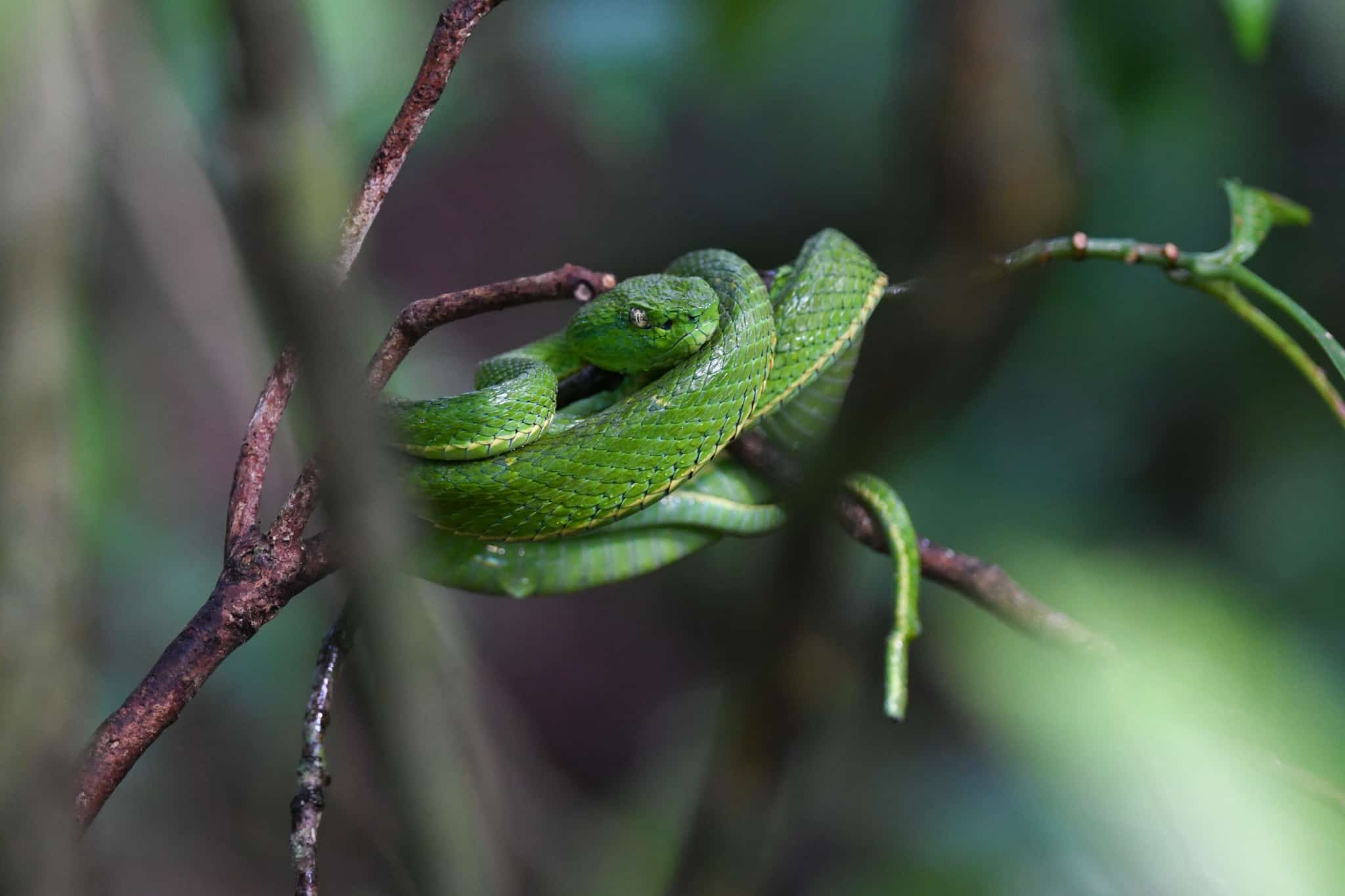
This venomous species does it all when it comes to branches: climbing 10 metres high, resting on thin and spindly branches, and staying for days in one position. Side-striped palm pitvipers measure up to 95cm, and inhabit the mountains of Costa Rica at 850-2100 metres. This species has a primarily haemorrhagic venom, and rarely kills its victims, although a 1984 report stated that Costa Rica averaged at 41 bites per year.
Bothriechis lateralis is capable of attacking humans from branches, just as they’re capable of seizing small mammals. This is true for thick arms 30cm in diameter and thin ones of just 5cm. They prey on meals such as rodents, bats and leaf litter anoles as younglings. With the ability to rest on most branches, not just the steadier ones, Bothriechis lateralis increases its chances of survival several-fold.
Another advantage is that the thinner branches are often superior for camouflage. These are the outer areas where thin fingery branches tend to overlap with those of the next tree, creating an impenetrable cloak of foliage 2 metres above the dark rainforest floor. This is useful both for ambush and bird-proofing safety. Likewise, coping with thin branches gives Bothriechis lateralis more escape routes. No snake wants to be pursued by a hungry bird and have to debate whether the left or right branch is more likely to snap.
| 6 | Rough green snake |
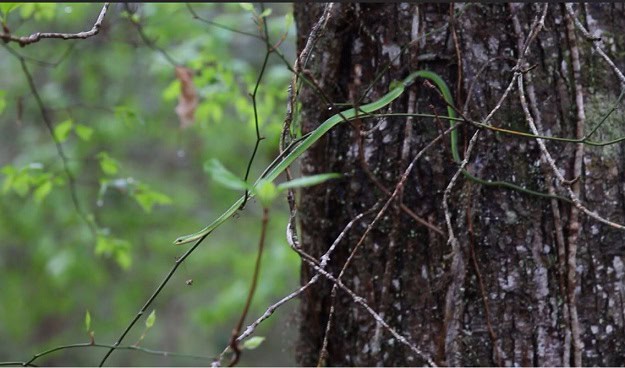
A harmless US snake, which is the cousin of the smooth green snake. The rough version is literally rougher to touch, and lives further to the south, inhabiting Georgia, Louisiana, Florida, Texas, and even northern Mexico.
Another difference is that rough green snakes (Opheodrys aestivus) are far more at home in trees than their cousin. They’re not inherently a tree snake, and they’re equally comfortable in long tufts of overgrown grass, but they ascend vertical trunks extremely easily. Once they’ve ascended, they weave effortlessly over the thinnest branches, including sharp spooky branches like those found in a haunted Halloween-style forest. Rough green snakes aren’t tiny, and reach a maximum of 116cm, yet their thin body makes them an expert tightrope walker on branches.
Rough green snakes also ascend especially high up trees. They’ve been observed by scientists clinging to branches 10 metres high, in a survey from White County, Arizona, and another handful were over 8 metres.
Rough green snakes are found neither in dense forests nor rocky plains. They prefer inbetween – moist meadows and woodlands. The same survey also revealed the rough green snake’s diet: caterpillars were most common, making up 40.6% of total food items. This was followed by spiders (24.6%), grasshoppers/crickets (11.3%) and dragonflies/damselflies (9.0%).
| 7 | Keeled slug snake |
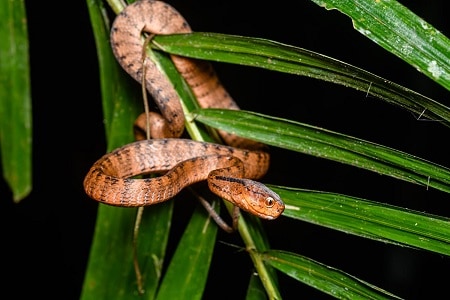
One of the dozens of slug/snail-eating snakes on Earth. The keeled slug snake belongs to the 30-member Pareas family, and ranges from the forests of Java to Vietnam. They’re usually found on low branches or bushes 1-2 metres above ground, where they rest on some of the thinnest branches imaginable. At 50-60cm, this species has little mass to cause them to snap and send them to a likely doom. This harmless snake has no venom whatsoever.
Keeled slug snakes (Pareas carinatus) prey on slugs as well as snails. If they couldn’t rest on ultra-thin branches, then their schemes would likely be over, as their main prey tend to be found sliming along these outer areas the most. Pareas carinatus isn’t an especially fast snake, slithering at a steady pace in order to creep up stealthily. However, its balance is supreme, and they instinctively wrap around a lower section of their body for support while stationary.
Moving towards outer branches also gives them a better view, revealing juicy new slugs sliming their way along. It helps that Pareas carinatus has especially bulging eyes, giving it a surround view of the forests. The slugs it spots may be on the next tree, requiring a leap of faith to the next branch, or at least it would require faith if they felt any fear (which they probably don’t).
This species coexists in most of Thailand and Malaysia with the white-spotted slug snake (Pareas margaritophorus), but instead of orange, the latter is a dark grey instead, with occasional white specks.
| 8 | Asian vine snake |
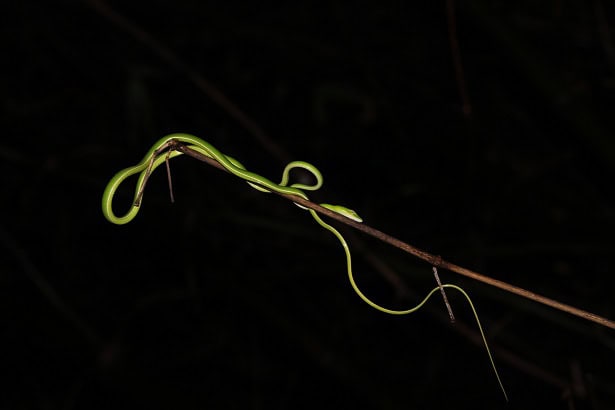
The Asian vine snake (Ahaetulla prasina) is a common species of Thailand, Vietnam and Cambodia, where they’re found in rainforests and damp evergreen forests. They measure 100-150cm with a maximum of 197cm, and you’re most likely to find them staring at you from a branch so thin and flimsy that you have no idea which tree it originates from.
The Asian vine snake’s lifestyle is designed around forests receiving high rainfall quantities. As such, they’ve adapted so that any branch is open to them, from thick tree arms with a family of frogs hidden inside, to branches so thin that they bend under pressure. Asian vine snakes are mildly venomous, but rarely attack humans. Their venom is like a highly diluted version of a viper’s, consisting mainly of metalloproteinases which degrade proteins in tissues, rather than neurotoxins.
The Asian vine snake can rest on the thinnest rainforest branches because they’re ultra-thin themselves. One of their favourite strategies is to fasten their prehensile tail, dangle down, and mimic a swaying vine in the breeze. Any house gecko that scampers past is doomed, unless they notice the yellow eyes carefully watching.
Asian vine snakes are easily capable of striking humans from branches. Though not dangerous, they can look intimidating, with their mouth gaping open wildly while they strike to create an impression of madness. Like a bronzeback, they can also cross gaps between thin branches, reaching new trees, aided by their unusually long tail.
| 9 | Amazon puffing snake |
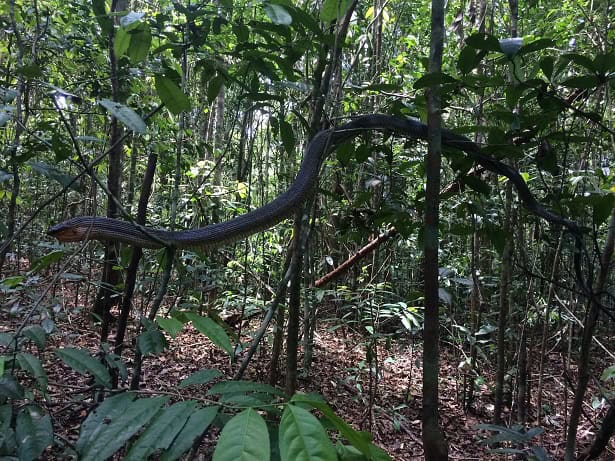
The Amazon puffing snake (Spilotes sulphureus) can navigate such thin branches that it appears to be floating in thin air. This species inhabits the entire Amazon region of South America, as well as the Atlantic coast (Sao Paulo, etc). This is a brute of a snake which can sometimes pass 3 metres, making them one of the Amazon’s longest species.
This snake is named for its defensive strategy when it inflates its throat grotesquely to scare away enemies; you can see this to a limited extent in the image above. But Amazon puffing snakes are venomous as well, and don’t rely purely on wacky intimidation tactics. Two toxins have been identified in its venom called sulditoxin and sulmotoxin 1, which are toxic against lizard prey and mammal prey respectively.
Amazon puffing snake snake don’t just navigate thin branches extremely carefully, using them to cross a large gap while taking extreme care, but they’ll sometimes relax on them for a while. Despite exceeding 3 metres, and having a relatively thick body for such an expert tree snake, this species is still fairly light. They combine this with sharp branch-navigating instincts, ingrained in their mind since birth.
Amazon puffing snakes are easy to find in a forest both due to their size, and their love of resting on thin, spindly branches around the height of a human’s head.
| 10 | Sumatran pitviper |
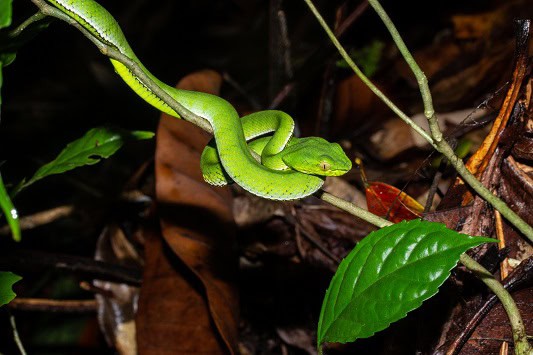
This venomous pitviper is found not just in Sumatra, but peninsular Malaysia and Borneo too. They’re found only in lowland rainforests, and only dense areas with a high percentage of canopy cover. Like most of their Trimeresurus pitviper relatives, this is a lazy ambush predator, and they’re able to rest calmly on even the thinnest, flimsiest branches.
Sumatran pitvipers (Trimeresurus sumatranus) can defy gravity and appear on branches that really ought to snap. Like the best branch snakes, they have a superior sense of stability and balance, and a thinner body than ground-based vipers. They move between branches purely instinctively, using no conscious thought, yet still avoid plummeting to the dangerous forest floor.
According to a study of Malaysian hospitals from 2017 to 2020, Trimeresurus sumatranus contributed 2.9% of venomous snakebites, making it a mid-ranking species. It’s unlikely that you’ll be bitten by one in a hotel garden while on holiday, as Trimeresurus sumatranus is a rainforest snake through and through. They have a large range, yet have such excellent camouflage in their rainforest that you’re likely to walk right past one, assuming it doesn’t lunge and bite. This snake is as far from the friendly corn snake in your Florida backgarden as possible.
Sumatran pitvipers reach a maximum of 160cm, making them one of the longer of their Trimeresurus pitviper family. This is a snake of branches, not the forest floor, whether it’s a sturdy fork between tree arms or spindly branch fingers.
